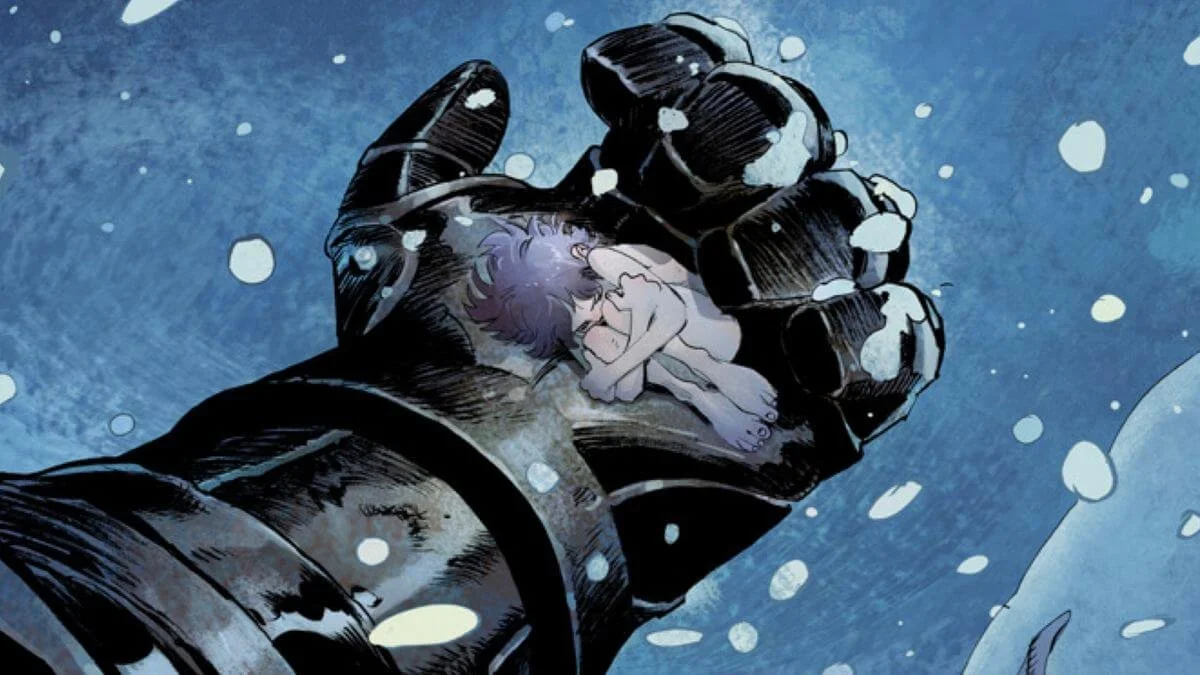Writer: Si Spurrier / Penciller: Matias Bergara / Colour Artist: Matheus Lopes / Collects Step By Bloody Step #1-#4 / SC / Image Comics
1st September 2022
Article by Paul Dunne
As the dialogue and caption-free Step By Bloody Step arrives in trade paperback, Paul takes the opportunity to discuss why we think of comics as a writer’s medium.
There's a lot of internal conflict in comics, for that is the nature of drama. Avengers Vs. X-Men. Batman V Superman. Steve Vs Tony. Eternals Vs. Everyone. How about 'Artist Vs Writer'? Long-time readers of the medium may find it strange, but increasingly there seems to be a component of fans who want to first ask the question: "Who is more important to a comic - the writer or the artist?", then of course want that question answered definitively one way or the other. No middle ground on Twitter, folks. But there is a lingering question that I struggle to answer, one a friend posed to me once: Do you like it because it's well-written... Or do you like it because it's well-written with great art? I think about that a lot lately. With Step By Bloody Step, Si Spurrier and Mathias Bergara, and Matheus Lopes are seemingly attempting to fox us further, making the answer to that question harder to procure. You see, Step By Bloody Step is a stunning-looking book...
Shorn of language.
Or rather, replacing the sometimes intrusive text of comics with the elegant visual language of art. This is interesting because, on a surface level, it renders the writer surplus to requirements, removing the obvious ways that they make their presence known in our happy medium: The dialogue and the captions.
I type 'happy medium' with a wry smile because if you check the dreaded socials, you'll see countless instances where sites and reviews have discussed the writer and NOT the art. This is a fair criticism. Look at how we talk about comics - it's Neil Gaiman's Sandman, Grant Morrison's All-Star Superman, and Frank Miller's Year One. Honestly, I've seen articles discussing upcoming books where the creative team was absent entirely. Because they make themselves, doncha know? Obviously, this is to say nothing of the other members of the creative team who often get left out of the conversation, the inkers, colourists, and letterers. Try reading a book where one of those elements isn't working, and see how you enjoy it. But it's getting away from me. I came here to ask: why do you think this is? Why are comics given only a single authorial stamp, despite being a very collaborative medium, where the names of those collaborators are quite literally written on the front of the piece?
Just spitballing here, but I wonder if it's because of the drive in the '80s to 'legitimise' this filthy art form. As we begged our teachers not to confiscate that copy of the Titan edition of Dark Knight Returns, we cried "They're not comics, they're graphic novels!" We rendered unto it a literary leaning, just so we could feel good about reading Wolverine on the tube and facing down the stares from respectable people. But comics were never respectable. At least not to outsiders. Everyone who accosted you on public transport (this happens to me personally - a lot) had the same thing to say: "I used to read comics... When I was a kid!" Essentially a backhanded insult suggesting you were somehow challenged as an adult and would, like Peter Pan, never grow up. So the medium grew up for you. It became a novel, with novel-length pretensions. And novels... Well, novels are a writer's medium, aren't they? Even authors that collaborate will often create new pseudonyms to hide the fact that there's more than one hand at work on the page.
But comic creators don't. Remember, for the most part, their names are right there on the front cover and again, somewhere in the book. So why do we forget so easily? I'll be honest and say it's not just readers who are guilty of this. I do it too. But, I also have to say that being more aware that others don't do it is making me look at those things a lot more carefully and consider them for longer. Does that come out in the writing? You be the judge. Deep down, do we only really want there to be one creator on the book? Do we really care about the artist? The evidence seems to point to yes. When I see tweets by friends or Insta posts, they're usually of good comic art. Their posts discuss good comic artists. But the notion that the writer is the true author still persists. To be fair. Writers and 'the industry' have taken steps to correct the preconception. Artists are now credited as co-creators in advertising and back matter (rightly). Now, we assume that the writer is the originator of the idea and this might be true of the central concepts of any given book, but once an artist comes on board, they have the power to change a comic substantially – usually for the better. Like actors cutting dialogue, because they're aware of their abilities and presence on screen, an artist will strip away unnecessary beats, add images that enhance and expand the story and create a fuller, more rounded creation. And that's just if they're on a work-for-hire basis. The ones who are there from the project's inception, crafting the book from the beginning are doing even more. So maybe we shouldn't be so quick to label comics with the auteur theory.
Another reason we will still cling to this theory for comics is, I'm sad to say, the film and television adaptations we said we always wanted and that are now flooding our eyeballs and incapacitating us with choices. There's never been a better time to be a comic book fan, but there's probably been a better time to be an artist if you want your work recognised. It's not that the artists aren't credited – although a few recently have had some completely just points to raise about that and the remuneration it brings or in a lot of cases doesn't bring – but that problems arise in translation. Quite simply, you can add all the technological advances you like, and you can base all the costumes you like on a particular artist's design... but getting that artist's style, getting the colourists tones... seems impossible. And would we even want it if it was? Yes, there have been things like Robert Rodriguez's Sin City or pretty much everything based on a comic directed by Zack Snyder which directly reproduces panels from comics, but that isn't an adaptation. That's replication. It's more the fluid dynamics and energy I'm talking about. I mean, can you imagine trying to get Wes Craig's style on screen? And so we're left with dialogue created by a comic writer, the moments, the ideas... is there much room for the comics artist there?
Look, I don't know about you, but I started off my comics collecting and reading by following characters. That was pretty much all that mattered to me. What was Batman up to? How many perps had Judge Dredd caught this week? What was going on in the Star Wars universe? Later, it was the writers... Who is this Alan Moore guy? Can anyone bring the same humanity to their books that Kurt Busiek can? Now I have to admit... It's the artists pulling me in. Javier Pullido or Marcos Martin did that issue? Buy it, son! Chris Samnee's on this? Out comes my wallet. Bergara? Welcome to the club, sir! My tastes have led me here, led me to be a creature driven by my eye. In short, I've simplified my selection process. We're taking in and processing so much visual information now, wanting our text to be shorter, faster, or better yet entirely absent. We want the emotion communicated quicker, as fast as our eye can take it in. And I have to admit that I'm no different. The eye is an easier, more instinctive master than the mind. But what of the book that’s stirred up all this debate in me once more?
The Pitch: There is a girl. She has no memory and no name. Nothing but a GUARDIAN. An armoured giant who protects her from predators and pitfalls. Together they walk across an extraordinary fantasy world. If they leave the path the air itself comes alive, forcing them onwards. Why? The girl doesn't know, but there's worse than beasts and bandits ahead. Civilisation, with its temptations and treacheries, will test their bond beyond its limits. Step By Bloody Step is a fantasy opus from the Eisner Award nominees behind Coda (sélection officielle Angoulême 2021): Matias Bergara (Hellblazer, The Scumbag) and Si Spurrier (X-Men: Legacy, Hellblazer, The Spire). Breaking new ground with the possibilities of sequential art, this completely wordless visual feast will delight fans of Princess Mononoke, and the visionary works of Moebius.
In a way, what we have in Step By Bloody Step is a product of the new, instinctive age. It's a brave step when you think about it. Writing something for which your particular talent is seemingly not present. So hats off to Spurrier for taking the chance. He and Bergara have crafted an epic, Tolkien-esque journey across a staggering landscape. The book moves with care and you feel the echoes of each page throughout the later stages of the book. Spurrier and Bergara have created a beautiful, evocative world, a 'no-place' you wished was someplace. One would almost be tempted to make a joke about 'faraway places with strange sounding names' – if only they had names! The design of the landscape feels fresh, yet familiar and will doubtless find fans in those of you that have read Coda. There is violence in this land too, but that is beautifully wrought. Nonetheless, the pain of it rings true. The book is a life cycle and one would do well to remember it takes two people to create life, lest you feel this is purely an endeavour of visual arts. The writer and artist are present here, even if the writer's presence feels a little more ephemeral. The colours by Matheus Lopes are eye-wateringly good, giving depth and resonance to those gorgeous lines. It's an amazing achievement and one that will very probably be on people's minds when the next round of comic awards is being voted on. Like LOTR, this represents the clash between the coming of machines and the black smoke they bring and the natural world, epitomised by a life-giving child, whose very blood can make the earth fertile. There's a nicely etched duality between the armoured giant, who brings death in order to protect life and the child, who brings life and the two characters feel like night and day. Although there is a deafening silence, the book speaks to both female empowerment and enslavement. There's war, thanks to which the girl becomes a bride, courted by one side, the golden goose that can create and build a new empire, which will, in turn, claim more lives and build a new, terrible world. Step By Bloody Step stays with you for a long time, and you'll want to revisit its pages and slowly learn more of its secrets. It doesn't matter who is more responsible for its creation. Everyone has created something glorious. And look, as for the debate on who is more important, the writer or the artist... it's obviously the -
Signed copies of Step By Bloody Step are available from Gosh! comics whilst stocks last. You can buy comics from The Comic Crush right here.







